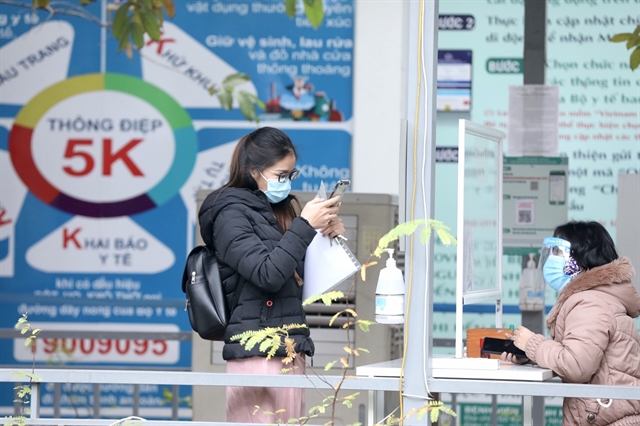 Opinion
Opinion


|
| A woman tested for COVID-19 in Thanh Nhàn Hospital. VNA/VNS Photo Minh Quyết |
In a recent interview with Vietnam News Agency, Nguyễn Trọng Khoa, deputy head of the Department of Medical Examination and Treatment under the Ministry of Health and a member of the ministry’s task force on COVID-19 prevention and control in HCM City, talked about how hospitals can protect themselves from COVID-19 now Việt Nam has shifted towards living with the pandemic.
The Government has switched from a zero COVID-19 policy to a safe and flexible adaptation to the pandemic. How should hospitals adapt to the new situation?
The Ministry of Health has issued directive documents and instructions, as well as assessment criteria regarding COVID-19 prevention and control at hospitals. We have also inspected and supervised their implementation. When we change our strategy to safe adaptation, we have to live safely with the pandemic and hospitals must also change and have tight control measures to minimise the risk of infections.
Hospitals must strictly conduct screening procedures. They must conduct testing for groups at-risk like inpatients, caregivers, medical workers and service providers. Regarding high-risk groups like hemodialysis patients, cancer patients and ICU patients, they must be tested more regularly and screened more carefully.
In case there are infections at hospitals whether they are patients, caregivers or medical workers, hospitals must be precise in isolation and identifying those in contact with infected cases. They need to isolate infected areas and maintain their operation in areas and departments that are not affected by the pandemic.
This is a great challenge for hospitals.
The department has directions and instructions for handling outbreaks for hospitals but each hospital should also have its own plan to handle the situation to minimise damages for them.
How does this shift change the pandemic prevention and control strategies of hospitals?
When we shift to adaptation there will be more infections in the community, and the risk of the pandemic spreading to hospitals is higher than when we implement social distancing measures or a zero COVID policy.
Patients come from many different areas and so do their caregivers. Medical workers also live in the community and go to work every day normally. It is difficult to manage to have no infections at hospitals.
Hospitals have to review their screening procedure to detect infections in a timely manner to mitigate the risks.
At the same time, they must be able to handle the outbreaks smoothly and precisely to protect their patients. Regarding this issue, the Ministry of Health has continued to have directions to hospitals in reviewing in-patients, ensuring vaccination for all unvaccinated or partially vaccinated, especially those with underlying conditions to reduce the risk of patients getting more severe conditions or deaths.
How have hospitals implemented their COVID-19 measures?
Hospitals have undergone a long time preventing and protecting themselves from COVID-19. This is not simple at all. It is a very big challenge and a burden for hospitals.
The difficulty for them is that over the last two years, they have to do screening for both in-patients and out-patients while still conducting regular activities such as Hemodialysis, Radiation therapy or surgery.
Besides health declarations, screening and other preventive measures, hospitals also do testing, which is a financial challenge as they have to do testing regularly and continuously.
Despite all these measures, we think that the emergence of infections at hospitals is understandable and they need to have a proper response.
They have to be quick and precise in handling outbreaks to minimise damages for both patients and activities of the hospitals so their activities are not disrupted.

|
| A woman scanning a QR health declaration code before entering Thanh Nhàn Hospital. VNA/VNS Photo Minh Quyết |
According to the Department of Medical Examination and Treatment, more than 80 per cent of COVID-19 cases are asymptomatic, which poses a great challenge to hospitals’ efforts in the prevention and control of COVID-19. What are your recommendations for hospitals? What needs to be done to stand ready?
My first recommendation is that hospitals need to have a procedure to assess the risk for different groups of people and departments at hospitals so they can work on specific plans and scenarios.
They should also conduct testing for certain groups more regularly to detect infections promptly.
When there are infections, we can isolate some departments but should avoid isolating the entire hospital because it’s the place patients rely on. Hospitals must be proactive with this.
We have also had many discussions, instruction documents and sharing sessions about screening and outbreak handlings at different hospitals so they have proper scenarios for different situations.
Besides major hospitals, district-level hospitals also have to receive mild and moderate COVID-19 cases. What should be taken into account to avoid infections at hospitals?
District-level hospitals play a very important role. Normally, there is only one district-level hospital in each district to treat basic diseases. COVID-19 has placed more tasks for them.
They have to maintain regular treatment and health checks while standing ready to receive COVID-19 cases. They also directed local health clinics to implement tasks like establishing mobile health stations or managing infected cases at home.
Moreover, they also have to enhance their capacity to not only treat mild cases but, in some cases, treat severe cases which need oxygen pumped into their airways. They must proactively prepare oxygen supply and conduct supplemental oxygen methods to ensure the upper-level hospitals are not overloaded with too many patients.
Before the peak of the pandemic, they also sent their medical workers, especially those specialising in infectious diseases, resuscitation or internal medicine to provincial level or central hospitals to join their colleagues in COVID-19 treatment.
By doing this, they can better handle the situation when the pandemic gets worse. VNS




